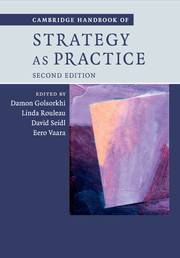Book contents
- Frontmatter
- Contents
- List of figures
- List of tables
- List of boxes
- List of contributors
- Preface to the Second Edition
- Introduction: what is strategy as practice?
- Part I Ontological and Epistemological Questions
- Part II Theoretical Resources: Social Theory
- Part III Theoretical Resources: Organization and Management Theories
- 16 An institutional perspective on strategy as practice
- 17 Relating strategy as practice to the resource-based view, capabilities perspectives and the micro-foundations approach
- 18 Theory of routine dynamics and connections to strategy as practice
- 19 Identity work as a strategic practice
- 20 Sensemaking in strategy as practice: a phenomenon or a perspective?
- 21 The communicative constitution of strategy-making: exploring fleeting moments of strategy
- 22 Analytical frames for studying power in strategy as practice and beyond
- 23 A critical perspective on strategy as practice
- Part IV Methodological Resources
- Part V Substantive Topic Areas
- Index
- References
20 - Sensemaking in strategy as practice: a phenomenon or a perspective?
from Part III - Theoretical Resources: Organization and Management Theories
Published online by Cambridge University Press: 05 October 2015
- Frontmatter
- Contents
- List of figures
- List of tables
- List of boxes
- List of contributors
- Preface to the Second Edition
- Introduction: what is strategy as practice?
- Part I Ontological and Epistemological Questions
- Part II Theoretical Resources: Social Theory
- Part III Theoretical Resources: Organization and Management Theories
- 16 An institutional perspective on strategy as practice
- 17 Relating strategy as practice to the resource-based view, capabilities perspectives and the micro-foundations approach
- 18 Theory of routine dynamics and connections to strategy as practice
- 19 Identity work as a strategic practice
- 20 Sensemaking in strategy as practice: a phenomenon or a perspective?
- 21 The communicative constitution of strategy-making: exploring fleeting moments of strategy
- 22 Analytical frames for studying power in strategy as practice and beyond
- 23 A critical perspective on strategy as practice
- Part IV Methodological Resources
- Part V Substantive Topic Areas
- Index
- References
Summary
Given the broad interest of strategy-as-practice scholars in the situated emergence of strategy from the actual actions, choices, cognitions, language and emotions of actors within organizations, it is inevitable that the literature has intersected with the sensemaking literature that has emerged around Karl Weick's work. Sensemaking has long been the dominant theoretical approach to meaning and interpretation in mainstream organization studies, including topics such as decision-making (Maitlis 2005), behaviours during crises (Weick 1993) and organizational change (Gioia et al. 1994). Sensemaking in fact provides a range of resources for theorizing, as it is less of a theory than a broad umbrella construct encompassing and synthesizing a range of observations and approaches from social theory, sociology and social psychology (Weick 1979).
In recent years, the concept of sensemaking has been regularly invoked and used as part of SAP research in empirical and theoretical work alike. Indeed, sensemaking has become such a central plank in the study of strategy practice that it is frequently mentioned as a theoretical foundation of the field (Balogun et al. 2014). In this chapter we review the various ways in which sensemaking is used in SAP research and elaborate its future potential to advance how we understand and research strategy practices, praxis and practitioners.
Our review of past strategy-as-practice research suggests that sensemaking was, and continues to be, used in a largely perfunctory manner alongside other theoretical sources, such as structuration and practice theory in SAP research, although the appropriation of the sensemaking literature has grown in prominence in recent years. We also find that the use of sensemaking is more varied than that of most other concepts – and is thus defined in somewhat different ways across SAP studies. In the broadest sense, scholars use the term ‘sensemaking’ to refer to a category of empirically observable practices, mostly relating to instances of individual thought and group conversations relating to strategy (Balogun et al. 2014). In other cases, scholars appropriate the sensemaking literature more explicitly to capture the interplay of interpretations and action as enactment (see Porac, Thomas and Baden-Fuller 1989).
Information
- Type
- Chapter
- Information
- Cambridge Handbook of Strategy as Practice , pp. 345 - 364Publisher: Cambridge University PressPrint publication year: 2015
References
Accessibility standard: Unknown
Why this information is here
This section outlines the accessibility features of this content - including support for screen readers, full keyboard navigation and high-contrast display options. This may not be relevant for you.Accessibility Information
- 7
- Cited by
